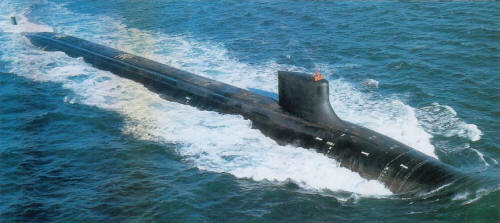
NAVYPEDIA
 Support the project with paypal
Support the project with paypal
Photo

Jimmy Carter 2005
Ships
| No | Name | Yard No | Builder | Laid down | Launched | Comm | Fate |
|---|---|---|---|---|---|---|---|
| SSN23 | Jimmy Carter | 256 | General Dynamics, Electric Boat Div., Groton | 12.12.1995 | 13.5.2004 | 19.2.2005 | in service (2020) |
Technical data
| Displacement standard, t | |
|---|---|
| Displacement normal, t | 8060 / 12139 |
| Length, m | 115.8 |
| Breadth, m | 12.8 |
| Draught, m | 11.0 |
| No of shafts | 1 pumpjet |
| Machinery | 2 geared steam turbines, 1 Westinghouse S6W nuclear reactor |
| Power, h. p. | 45500 |
| Max speed, kts | / 30 |
| Fuel, t | nuclear |
| Endurance, nm(kts) | practically unlimited |
| Armament | 8 - 673 TT (amidships, 50 torpedoes, inc. 12 Tomahawk UGM-109 CruM instead of part of torpedoes or 100 mines), 3 BLQ-11 minehunting USV |
| Military load | 50 SEALs, DDS or ASDS |
| Electronic equipment | BPS-16(v)4 radar, BQQ-5D sonar suite (BQS-24 sonar, TB-23, TB-16D towed arrays), WLQ-4(v)1 ECM suite, BLD-1 D/F, BLQ-10 decoy launchers, BSY-2(v) CCS |
| Complement | 133 |
| Diving depth operational, m | 595 |
Standard scale images

Jimmy Carter 2010
Graphics
Project history
This was the first new attack submarine to be designed after the Los Angeles class. There had been several proposals during the 1970s, but none was considered sufficiently superior to the gradually evolving Los Angeles. The new Seawolf combined a new quieter reactor with a new quiet propulsion (a pumpjet), a better hull shape (lower length / beam ratio), and much more firepower, in the form of twice as many tubes and twice as many internally-stowed weapons. Seawolf is somewhat faster than Los Angeles, but it has a much higher quiet (tactical) speed, reportedly about twice that of the earlier class. The new submarine is equipped with a new distributed combat system, BSY-2, which incorporates a new bow sonar (a pair of spheres), the flank array (WWAA) installed on late Los Angeles class boats, and a pair of towed arrays (a thick TB-16D and a thin TB-29). There is also an active ice- and mine-avoidance sonar, SADS/MIDAS. Seawolf was designed for relatively inexpensive maintenance, so that although its unit cost is very high, its total life-cycle cost is intended to match that of earlier submarines. Overhaul (including reactor refuelling) should not be necessary for fifteen years. The first unit was authorised in FY89, for launching in January 1994 and completion in May 1995. These dates probably were not be met, because difficulties were experienced in welding its new HY-100 steel. The torpedo tubes were originally referred to as being 762mm in diameter, but liners and other fittings restrict the diameter of weapons and remotely controlled reconnaissance vehicles launched from them to 673mm; the launch system is virtually soundless, but the outer doors can not be opened when the submarine is traveling at maximum speed.
Seawolf was also called SSN-21, the nuclear submarine of the twenty-first century, and this new number superseded the original hull number, SSN774, on numerous official documents. SSN22 was authorised under FY91 and SSN23 under FY92, although final construction authority was not granted by Congress until FY96 and funding was not provided until FY97. As of 1999, the total cost of the three-submarine program was estimated at $16 billion.
Opposition to mass production of so expensive a submarine led the navy to work on a less expensive follow-on Virginia class, initially called 'Centurion'.
29.1.1999 USN announced that SSN23 was to be longer to incorporate advanced technologies and the capability to carry special warfare forces, modification delayed her launch by 27 months. The additional 8.2m section can accommodate 50 SEALs and their equipment, plus displays for remote-controlled minehunting submersibles and other remotely operated vehicles, which are stowed in a flush hangar-like section. 1.52m-diameter airlock was fitted to allow deploying personnel and submersibles from within the pressure hull. The SSN23 replaced the SSN683 Parche.
Modernizations
planned: - BQQ-5D sonar suite, TB-16D towed array, BSY-2(V) CCS; + BQQ-10 sonar suite, TB-34 towed array, BLQ-10 ECM, BYG-1 CCS
Naval service
No significant events.
 HOME
HOME FIGHTING SHIPS OF THE WORLD
FIGHTING SHIPS OF THE WORLD UNITED STATES OF AMERICA
UNITED STATES OF AMERICA SUBMARINES
SUBMARINES JIMMY CARTER nuclear powered special purpose submarine (2005)
JIMMY CARTER nuclear powered special purpose submarine (2005)
